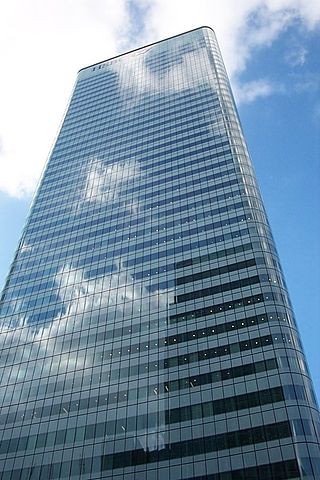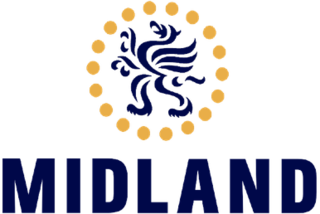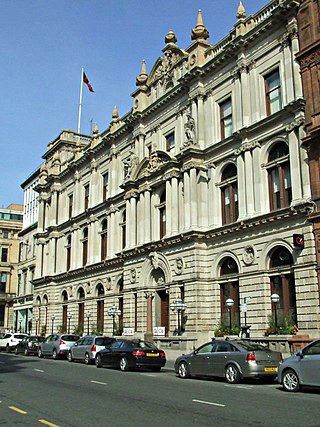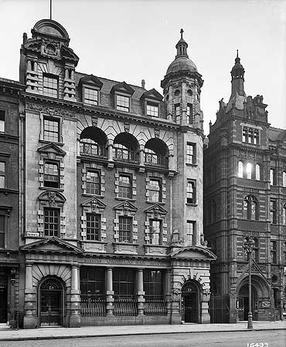Related Research Articles

HSBC Holdings plc is a British multinational universal bank and financial services holding company. It is the largest bank in Europe by total assets ahead of BNP Paribas, with US$2.953 trillion as of December 2021. In 2021, HSBC had $10.8 trillion in assets under custody (AUC) and $4.9 trillion in assets under administration (AUA), respectively. HSBC traces its origin to a hong in British Hong Kong, and its present form was established in London by the Hongkong and Shanghai Banking Corporation to act as a new group holding company in 1991; its name derives from that company's initials. The Hongkong and Shanghai Banking Corporation opened branches in Shanghai in 1865 and was first formally incorporated in 1866.

Yorkshire Bank is a trading name used by Clydesdale Bank plc for its retail banking operations in England.

The Trustee Savings Bank (TSB) was a British financial institution. Trustee savings banks originated to accept savings deposits from those with moderate means. Their shares were not traded on the stock market but, unlike mutually held building societies, depositors had no voting rights; nor did they have the power to direct the financial and managerial goals of the organisation. Directors were appointed as trustees on a voluntary basis. The first trustee savings bank was established by Rev. Henry Duncan of Ruthwell in Dumfriesshire for his poorest parishioners in 1810, with its sole purpose being to serve the local people in the community. Between 1970 and 1985, the various trustee savings banks in the United Kingdom were amalgamated into a single institution named TSB Group plc, which was floated on the London Stock Exchange. In 1995, the TSB merged with Lloyds Bank to form Lloyds TSB, at that point the largest bank in the UK by market share and the second-largest by market capitalisation.
HSBC Bank Canada, formerly the Hongkong Bank of Canada (HBC), is a Canadian chartered bank and the Canadian subsidiary of British multinational banking and financial services company HSBC. HSBC Canada is the seventh largest bank in Canada, with offices in every province except Prince Edward Island, and is the largest foreign-owned bank in the country. The corporate headquarters are located at the HSBC Canada Building in the downtown core's financial district of Vancouver, British Columbia. HSBC Bank Canada's Institution Number is 016.

HSBC Bank Malta plc is the Maltese subsidiary of the British multinational banking and financial services company HSBC. The company is headquartered in Qormi and operates over 30 branches and offices throughout the islands of Malta and Gozo. HSBC Bank Malta is part of the European region within HSBC and therefore reports to HSBC Bank plc.

Midland Bank Plc was one of the Big Four banking groups in the United Kingdom for most of the 20th century. It is now part of HSBC. The bank was founded as the Birmingham and Midland Bank in Union Street, Birmingham, England in August 1836. It expanded in the Midlands, absorbing many local banks, and merged with the Central Bank of London Ltd. in 1891, becoming the London City and Midland Bank.

The Hongkong and Shanghai Banking Corporation Limited, commonly known as HSBC, was the parent entity of the multinational HSBC banking group until 1991, and is now its Hong Kong-based Asia-Pacific subsidiary. The largest bank in Hong Kong, HSBC operates branches and offices throughout the Indo-Pacific region and in other countries around the world. It is also one of the three commercial banks licensed by the Hong Kong Monetary Authority to issue banknotes for the Hong Kong dollar.

Marine Midland Bank was an American bank formerly headquartered in Buffalo, New York, with several hundred branches throughout the state of New York. In 1998, branches extended to Pennsylvania. It was acquired by HSBC in 1980, and changed its name to HSBC Bank USA in 1999. As a result of several transactions since the turn of the millennium, much of what was once Marine Midland is now part of KeyBank with the exception of Downstate New York and Pennsylvania. that is now part of Citizens Bank. Branches in Seattle are part of Cathay Bank.
HSBC Bank A.Ş., the Turkey subsidiary of the HSBC Group, is a bank with its head office in Istanbul.

HSBC UK Bank plc is a British multinational banking and financial services organisation based in Birmingham, England. It is part of HSBC Holdings.
HSBC Bank USA, National Association, an American subsidiary of multinational company HSBC, is a bank with its operational head office in New York City and its nominal head office in McLean, Virginia. HSBC Bank USA, N.A. is a national bank chartered under the National Bank Act, and thus is regulated by the Office of the Comptroller of the Currency (OCC), a part of the U.S. Department of the Treasury. The company has 159 branch locations.

Clydesdale Bank plc is a retail and commercial bank in the United Kingdom. It was formed in Glasgow, Scotland in 1838, and is the only former Scottish bank which retains its UK headquarters in Scotland, following the implosions in 2008 of the Bank of Scotland and of the Royal Bank of Scotland.
HSBC Bank Argentina S.A. is the principal HSBC operating company in Argentina. The seventh-largest bank in the country, it provides a full range of banking and financial products and services, including commercial, consumer and corporate banking, to over 1.2 million customers.
The Erewash Valley Line is a railway line in England, running from Long Eaton, located between Nottingham and Derby, and Clay Cross, near Chesterfield. The southern part was opened by the Midland Railway in 1847 as far as Codnor Park, where it connected to established ironworks, and soon after, a line to Pinxton and Mansfield.
The Oxford, Worcester and Wolverhampton Railway (OW&WR) was a railway company in England. It built a line from Wolvercot Junction near Oxford to Worcester, Stourbridge, Dudley and Wolverhampton, as well as some branches.

Cyprus Popular Bank was the second-largest banking group in Cyprus behind the Bank of Cyprus until it was 'shuttered' in March 2013 and split into two parts. The 'good' Cypriot part was merged into the Bank of Cyprus and the 'bad' part or legacy entity holds all the overseas operations as well as uninsured deposits above 100,000 Euro, old shares and bonds. The uninsured depositors were subject to a bail-in and became the new shareholders of the legacy entity. As at May 2017, the legacy entity is one of the largest shareholders of Bank of Cyprus with 4.8% but does not hold a board seat. All the overseas operations, of the now defunct Cyprus Popular Bank, are also held by the legacy entity, until they are sold by the Special Administrator, at first Ms Andri Antoniadou, who ran the legacy entity for two years, from March 2013 until 3 March 2015. She tendered her resignation due to disagreements, with the Governor of the Central Bank of Cyprus and the Central Bank Board members, who amended the lawyers of the legacy entity, without consulting her. Veteran banker Chris Pavlou who is an expert in Treasury and risk management took over as Special Administrator of the legacy entity in April 2015 until December 2016. The legacy entity is pursuing legal action against former major shareholder Marfin Investment Group.
First Niagara Bank was a Federal Deposit Insurance Corporation-insured regional banking corporation headquartered in Buffalo, New York. Its parent company, First Niagara Financial Group, Inc. was the 44th-largest bank in the United States with assets of over $37.1 billion as of June 30, 2013. Their slogan is "Do Great Things"

The historic overseas bank was established in London in 1828 as Leslie & Grindlay, agents and bankers to the British army and business community in India. Banking operations expanded to include the Indian subcontinent, the Middle East and elements of Africa and Southeast Asia. It was styled Grindlay, Christian & Matthews in 1839, Grindlay & Co from 1843, Grindlay & Co Ltd from 1924 and Grindlays Bank Ltd in 1947 until its merger with the National Bank of India.
Charles Geach was a prominent English businessman, industrialist, banker and politician of the early to mid-19th century, strongly associated with banking and manufacturing interests. He was a co-founder and the general first manager of the Midland Bank, the first treasurer of the Institution of Mechanical Engineers, a prominent investor in several major engineering businesses, and MP for Coventry from 1851 to his premature death, aged 46, in 1854.
The North Western and Charing Cross Railway (NW&CCR) was a railway company established in 1864 to construct an underground railway in London. The NW&CCR was one of many underground railway schemes proposed for London following the opening in 1863 of the Metropolitan Railway, the world's first underground railway, but was one of only a few to be authorised by Parliament. The company struggled to raise funding for the construction of its line and was twice renamed, to the Euston, St Pancras and Charing Cross Railway and the London Central Railway, before the proposals were abandoned in 1874.
References
- ↑ Capie, Forrest; Webber, Alan (2013). A Monetary History of the United Kingdom: 1870-1982. Routledge. p. 539. ISBN 9781136601835.
- ↑ "HSBC UK (Midland Bank) Archive". HSBC History. Retrieved 30 January 2023.
- 1 2 3 4 5 Orbell, John (5 July 2017). British Banking: A Guide to Historical Records. Routledge. ISBN 9781351954679.
- ↑ "History timeline - About HSBC | HSBC UK". www.about.hsbc.co.uk. Retrieved 22 August 2017.